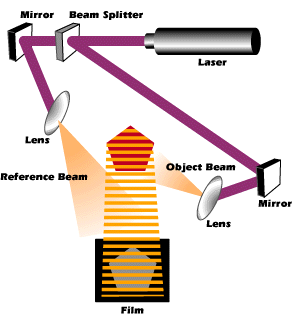|
Hologram: the
intermediate photograph (or photographic record) that contains information for
reproducing a three-dimensional image by holography (www.hyperdictionary.com) Holography: the branch of optics that deals with the use of coherent light from a laser in order to make a hologram that can then be used to create a three-dimensional image (www.hyperdictionary.com) In simpler words: The hologram is the photo of a 3-dimensional object (or scenery) recorded on a film. The film itself does not show the image, just a wave pattern - but if hit by a beam of special light, a projection is created in space which looks 3-dimensional again. So, holography records 3 dimensions on a 2-dimensional (flat) medium. Quite a trick! |
|

